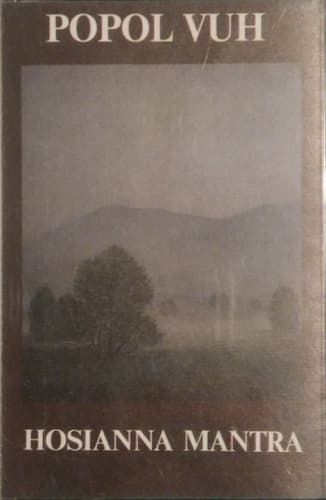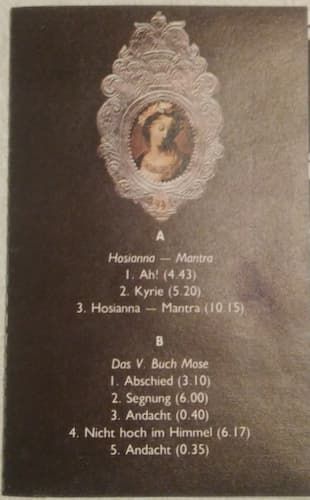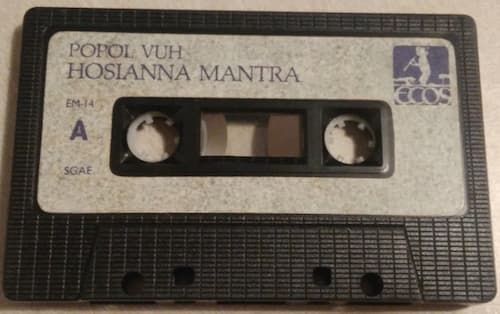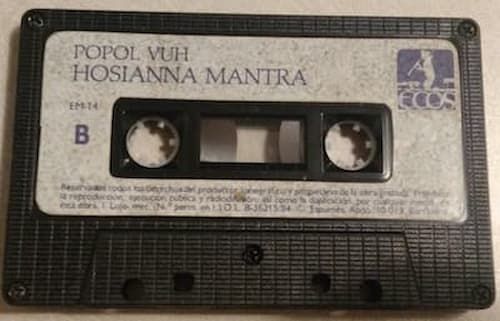HOSIANNA MANTRA
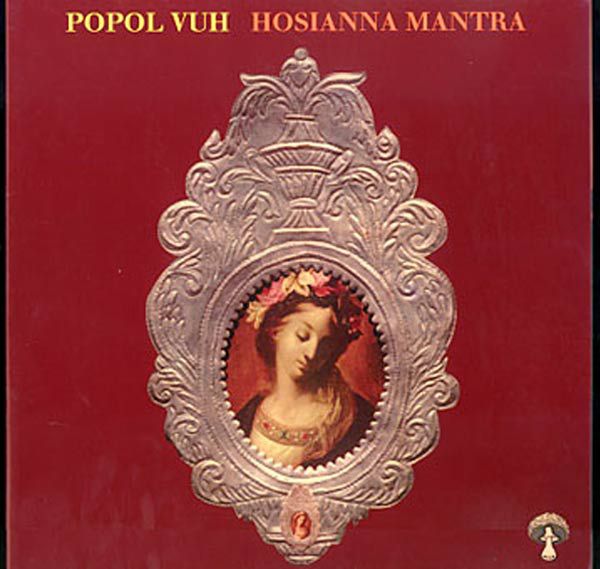
LP: Cosmic Music/Ohr/Barclay 840.061 - 1973 - France
LP: Pilz 20 29143-1 - 1973 - Germany
LP: Kosmic Kurrier 940119 - 1973
LP: Pilz/Pop Import 20 29143-1 - 19... - Germany
LP: PDU Pld.SQ 5094 / PMA 594 / P8A 30094 - 1972 - Italy
CS: PDU 594 - 1974 - Italy
LP: Celestial Harmonies CEL 004 - 1981 - USA & Germany
CS: Celestial Harmonies CEL 004 - 1981 - USA [ two edtions ]
LP: Celestial Harmonies - South Korea
CS: Ecos EM 14 - 1985 - Spain
CS: Celestial Harmonies CEL 13004 - 1992
CD: Spalax SPA 14209 - 1992 - France
LP: Spalax - Germany - 1994
CD: King-Nexus KICP2729 - Japan - 1994
CS: Ananda Music AM 039 - Poland
CD: Zyx Music 2029143-2 / OHR - Germany - 1999
CD: High Tide 9126-2 - 1994 - Italy [ Bonus 3 part suite ‘Spirit of Peace': 3:33 - 7:27 - 9:45 ]
LP: Think Progressive TPLP 1.803.023 - 1993 - Germany [ 180 gr vinyl ]
CD: ZYX OHR 70022-2 - Germany - 1999
CD: Pilz - 1999
CD: SPV 085-70122 CD - 2004 - Germany [ With bonustracks ]
CD: Vivid- 2004 [same as SPV release]
CD: Belle Antique MAR 04974 - Japan - 2004
CD: Arcangelo ARC 7184 - Japan - 2006 [ Same as SPV-release ]
CD: Belle Antique BELLE 121999 - Japan - 2012 [ Same SPV-release ]
LP: Wah Wah LPS118 - Spain - 2013 [ With inserts & single ''Du sollst lieben/Ave Maria; 2 x 500 copies ]
CD: Ananda Music AM 128 - Poland - 2015
CD: BMG 538392292 - 2018 - Germany [Tracklist same as SPV. Newly remastered by G.Hieronymus & F.Fiedler ]
LP: Esoteric/Cherry Red ECLECLP2921 - UK - 2025 [ remastered ]
LP: Esoteric/Cherry Red ECLECLPX2921 - UK - 2025 [ remastered; limited edition clear vinyl ]
Track list from Pilz 20 29143-1 - 1973:
1
(Hosianna - Mantra)
Ah! - 4:43
Kyrie - 5:20
Hosianna-Mantra - 10:15
2
(Das V. Buch Mose)
Abschied - 3:10
Segnung - 6:00
Andacht - 0:40
Nicht hoch im Himmel - 6:17
Andacht - 0:35
Track list from Celestial Harmonies CEL 004 - 1981:
1
Ah! - 4:43
Kyrie - 5:20
Hosianna Mantra - 10:15
2
Departure - 3:10
Blessing - 6:00
Devotion I - 0:40
Not high in Heaven - 6:17
Devotion II - 0:35
Extra track on SPV 085-70122 - 2004:
Maria (Ave Maria) - 4:30
Liner notes from Pilz 20 29143-1 - 1973:
Popol Vuh - piano, cembalo
Conny Veit - E & 12 string guitar
Robert Eliscu - oboe
Djong Yun - sopran
Klaus Wiese - tamboura
Gast:
Fritz Sonnleitner - violin
Sämtliche Kompositionen und Texte: Popol Vuh
(Texte nach einer Übersetzung von Martin Buber)
Mixdown: Peter Kramper
Recording Engineers: Wolfgang Löper, Hans Endrulat
Assistent: Toni Heudorf
Photography: Bettina Fricke
Cover Design: Ingo Trauer, Richard J. Rudow
1973:
Rainer Langhans: Die neue Langspielplatte heißt HOSIANNA MANTRA. Deutet das darauf hin, daß ihr euch nun mit abendländischer Kirchenmusik beschäftigt?
Florian Fricke: Schon die LP IN DEN GARTEN PHARAOS ist eine irgendwie sakrale, ergriffene Musik; sie zeigt das noch nicht so deutlich, da die Musik rein instrumental ist und niemand darauf ein religiöses Wort singt. Beim komponieren von HOSIANNA MANTRA bin ich von christlichen Textinhalten ausgegangen. Wir haben lange nach einer geeigneten Sängerin gesucht. Es war ein Wagnis, das ich nur dem Text zuliebe eingegangen bin. Ein freund aus Berlin hat uns dann eines Tages mit dem koreanischen Mädchen Djong Yun zusammengebracht und wir konnten nach vier Wochen Proben mit ihr ins Studio gehen.
In meinem Selbstverständnis ist HOSIANNA MANTRA sehr christlicher Musik; Kirchenmusik kann man sie nicht nennen, außer du verstehst deinen eigenen Körper als Kirche und die Ohren als ihren Eingang.
Conny Veit: Auch ich nehme Abstand von der Klassifizierung ‘Kirchenmusik’, obwohl ich es durchaus für möglich und angemessen halte, daß HOSIANNA MANTRA als Kirchenmusik Anwendung findet. Eigentlich ging es mir bei der Realisierung dieser Platte um etwas andres. Ich wollte mit meinen mit mir zur Verfügung stehenden Mitteln urchristliches Sein und Fühlen erfassen, um die Richtigkeit elementarer Wahrheiten im christlichen Wort zu vermitteln. Nicht als Prediger, sondern als einer, dem archaische Lebensformen wertvoller und richtiger erscheinen als unsere eigene Jetzt-Kultur.
[....]
Rainer Langhans: Warum diese Auswahl an Texten und was bedeutet die Textstelle “Sehr nahe ist dir das Wort” und “es”, also das Wort “es zu Tun”, und warum war dir diese Textstelle so wichtig, daß du sie ausgesucht hast?
Florian Fricke: “Schon während der Arbeit am ‘Pharao’komponierte ich an der ‘Segnung’aus dem 5. Buch Mose. Für mich war es immer ein Liebeslied an meine Frau.
Der Text, der heute auf HOSIANNA MANTRA ‘Nicht hoch im Himmel’heißt, war damals auch schon bekannt - ich glaubte aber, seine Vertonung wäre zu schwer für mich. Andererseits hat er mich als klare, unmisverständliche Definition vom Religiösen tief beeindrückt. Ich habe das Lied dann doch kurz vor dem Studiotermin komponiert.Der Text erschien mir auch deshalb so wichtig, weil ich wußte, daß eine religiöse Platte heutzutage sicherlich vielen Mißverständnissen ausgesetzt ist - und dieser Text sagt doch klar, daß Religion keine sache ist außerhalb der Reichweite des Menschen, sondern daß Gott hier ist, hier unten, in unserem Tun, Sprechen und Fühlen. Ja, das ist wichtig zu sagen.
Dies sind die Texte der B-Seite. Die A-Seite ist eine kleine ‘Messe’ von Popol Vuh. Das erste Stück ‘Ah’ist ein Staunen. Ich habe mit meinem Spiel am Klavier versucht, daß Rückgrat zu berühren, Terzenläufe rauf und runter, und Conny spielt so, als wäre er gerade aus einem tiefen Schlaf erwacht, schaut sich verwundert um und sagt: ‘Das gibt’s ja gar nicht!’
Das anschließende ‘Kyrie’ist ein in gewisser Weise klassisches ‘Kyrie Eleison’und mehr noch als das erste Stück Vorbereitung für das große zentrale ‘Hosianna Mantra’. Da hatte ich die vor Augen, die dem Jesus auf dem Maultier beim Einzug in Jerusalem zujubeln: ‘Hosianna, Sohn Davids!’ Wenn ich das Stück spiele, dann stehe ich in dieser Schar der Bedürftigen und sage mir: “So jetzt bist du dran”, und dann spiele und singe ich zu dieser, wenn man so will, schäbigsten Krönung aller Zeiten. (Sounds)
1993:
Keyboards: Was kam dann, nachdem du dich von der elektronik abgewandt hattest?
Florian Fricke: Nach dem beiden elektronischen Platten habe ich sofort mit herkömmlichen, akustischen Instrumenten wie Klavier, Gitarre, Oboe und Gesang die Platte ‘Hosianna Mantra’ aufgenommen. Was die musikalische Form und Gestaltung anbelangt, so gab es keinen Unterschied. Auch bei ‘Hosianna Mantra’ habe ich ein tiefes seeliches Schwingen angestrebt und verwirklicht. ‘Hosianna Mantra’ wurde so etwas wie ein Wegbereiter für die heutige New Age-Musik.
[...]
Florian Fricke: Hosianna Mantra wurde in den Bereich von Religion gebracht - wohl auch deshalb, weil die Texte aus der Bibel stammten. Trotzdem war mir das Image nicht recht, religiöse Musik zu machen, weil ich immer nur versucht habe, Musik für den Menschen, für dessen herz und dessen Seele zu machen. Wenn das religiös ist, dann meinetwegen, aber mit irgendwelchen kirchlicher Gebundenheiten hatte ich wirklich nie etwas im Hut. (Keyboards)
1996:
Gerhard Augustin: It is said that HOSIANNA MANTRA is a musical Mass.
Florian Fricke: Yes, in a way it was a Mass, a church Mass. But not for church! A conscious reflection upon religious origin is included in this music, but not in particular to any religious groups.
Gerhard Augustin: In HOSIANNA MANTRA there are some new personnel, such as Conny Veit and Djong Yun. How did you meet them, and how did you come to play with them? Let's first talk about Conny Veit. How did you meet him?
Florian Fricke: Actually, most of the musicians have always sort of found their way to me to play with me. I met Conny Veit at United Artists, my record label at the time, in the office of somebody I knew there (actually GA himself).
Gerhard Augustin: But this is how Conny started playing with you, he came to your house and you guys just sat down and played?
Florian Fricke: Yes, and he has did this every day. And that is how we actually prepared for almost half a year to records the album HOSIANNA MANTRA.
Gerhard Augustin: And then Djong Yun, how did she come into the picture?
Florian Fricke: Djong Yun came to Munich; she is the daughter of a famous composer. She got the melodies, she was listening to what we were playing and she heard the melodies and started singing with us. Yeah, we called it rehearsal! [laughs]
Gerhard Augustin: Did you, Conny Veit and Djong Yun ever perform as a band, publicly?
Florian Fricke: Yes we did, actually, in Lieberkosen and Munich.
Gerhard Augustin: Tell us, what was the theme and how did you get the ideas of recording HOSIANNA MANTRA? And then can you tell us something about the artwork?
Florian Fricke: In creativity there are not always reasons. Some of the things are just flying straight through the window. But at that time I was especially interesting in using first the words, and then making music to the words, in other words there were existing lyrics that I wanted to add music to. I wanted to convey the depth of meaning contained in a word, and then transform this into musical sounds, a from of musical expression. That is one way of composing music for me. I don't always do it, but on and off I keep having an interest in composing in such way.
Gerhard Augustin: The name HOSIANNA MANTRA, where does it come from?
Florian Fricke: HOSIANNA MANTRA is actually a combination of two different cultures, two different languages, two different lives. It has a dual meaning, "Hosianna" which is a religious Christian word, and "Mantra" from the Indian religion of Hinduism. Behind all of that I was convinced that basically all religions are the same. You always find it in your own heart. And the music of HOSIANNA MANTRA is really touching your heart. It is made to touch your heart. That is why you can call it a Mass. A Mass for your own heart.
Gerhard Augustin: Can you remember any episodes in making the album HOSIANNA MANTRA?
Florian Fricke: I do remember when you ask me about episodes. One of the episodes was that Djong Yun was combing her hair more than she was taking time to rehearse our music. It was much more important to her personally to be pretty and beautiful for all of us. To look the way she felt comfortable in order to sing comfortably. We had absolutely nothing against that because she had very beautiful hair. Her hair is as beautiful as her voice. She was really a very nice, comfortable part of the group. Her behavior and everything was very soothing. But in general this production was no different from all the other productions. We’d go prepared into the studio having a certain amount of ideas and music available, and then improvise in addition to what we had already constructed. I've always looked for the fact that whenever we make music, or we were producing music, that whoever is part of the group playing, is responsible for their own playing within that formation. Groupies were not allowed. [laughs]
Gerhard Augustin: How did you really get to meet Djong Yun, the very first time? Have you heard about her from other friends?
Florian Fricke: In those days I was living in Munich in Halachein. Musicians from other towns and cities that came to town came to Munich, by recommendation or desire or whatever, came by my house, and we were just jamming. One day Djong Yun came there. I was playing with Andy Fix, the guitar player, and he was talking about this incredible girl from Berlin, this singer from Berlin, and he said that I had to meet her. That she was fantastic. I was working with Esther Ofarim in those days, but it didn't work out because she refused to sing Christian lyrics, being Jewish I guess, so she didn't want to interpret this kind of song. Which I did understand. In those days there was not this competitive feeling among musicians, and the contacts were loose and open. People were just visiting each other for the sake of music, and not to discuss their recording contracts. In a certain way we were all hippies in those days.
Gerhard Augustin: I feel that this album HOSIANNA MANTRA is one of the greatest albums that German rock has produced in the '70s. What, in your opinion, does this album mean to you, and what position does this album take in the career of Popol Vuh for you?
Florian Fricke: When HOSIANNA MANTRA was released we had a great feedback from the press and the public. There were these voices that said HOSIANNA MANTRA was certainly the most beautiful record that had been made until that day. Personally, I still consider this music as incredibly beautiful. But very rarely do I listen to music that I have made in the past. I'm always living with the music that I'm now realizing, or producing, or making, whatever. So I don't really dwell in the past, and I don't think too much of the past, I think more about tomorrow, the future, and what's happening right now. (Eurock)
no reviews yet.
‘Gnadenbild Maria, Mutter der Schönen Liebe’ ( The miraculous image of Mary, Mother of Fair Love)
This is a work by the Benedictine monk Innozenz Metz OSB (c. 1640–1724) and is located on the left side altar of the parish church of St. John the Baptist in Wessobrunn (about 65 km southwest of Munich). It is based on the biblical passage in Sirach 24:18: “I am the mother of fair love, of the fear of the Lord, of knowledge, and of faithful hope. In me is all the loveliness of the way and of truth, in me all the hope of life and of virtue.” Mary’s downcast gaze suggests her quiet contemplation of God’s plans.
Source: : https://de.wikipedia.org/wiki/Gnadenbild_Maria,_Mutter_der_Schönen_Liebe
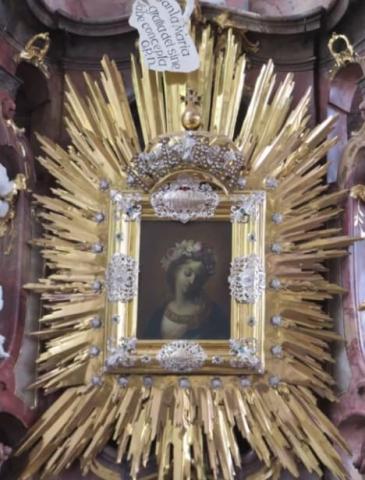
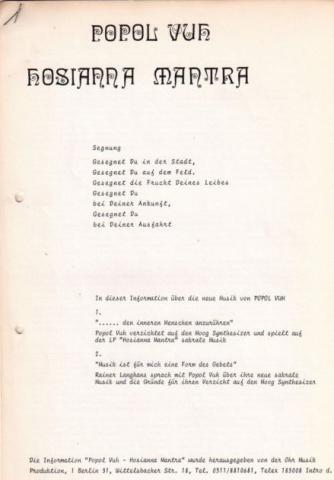
Promosheet
PILZ:
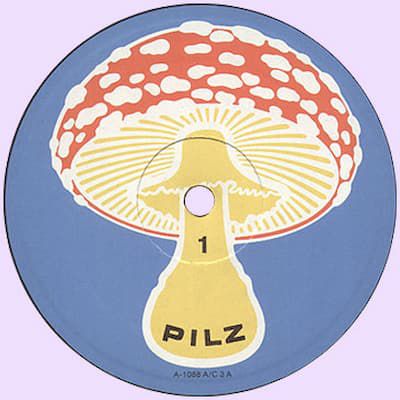
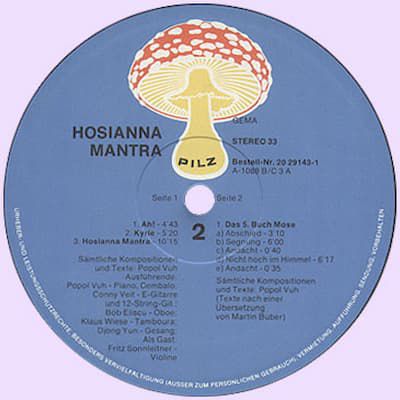
CELESTIAL HARMONIES
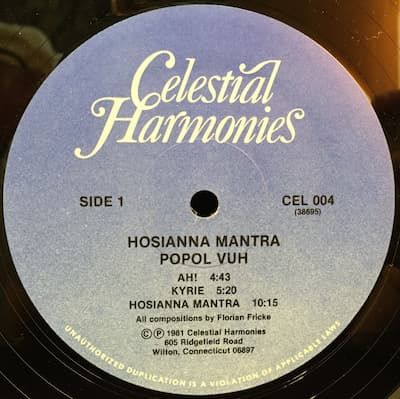
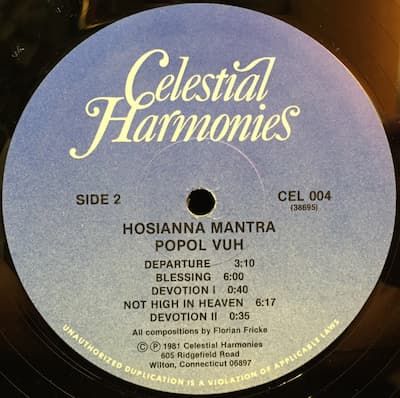
POP IMPORT:
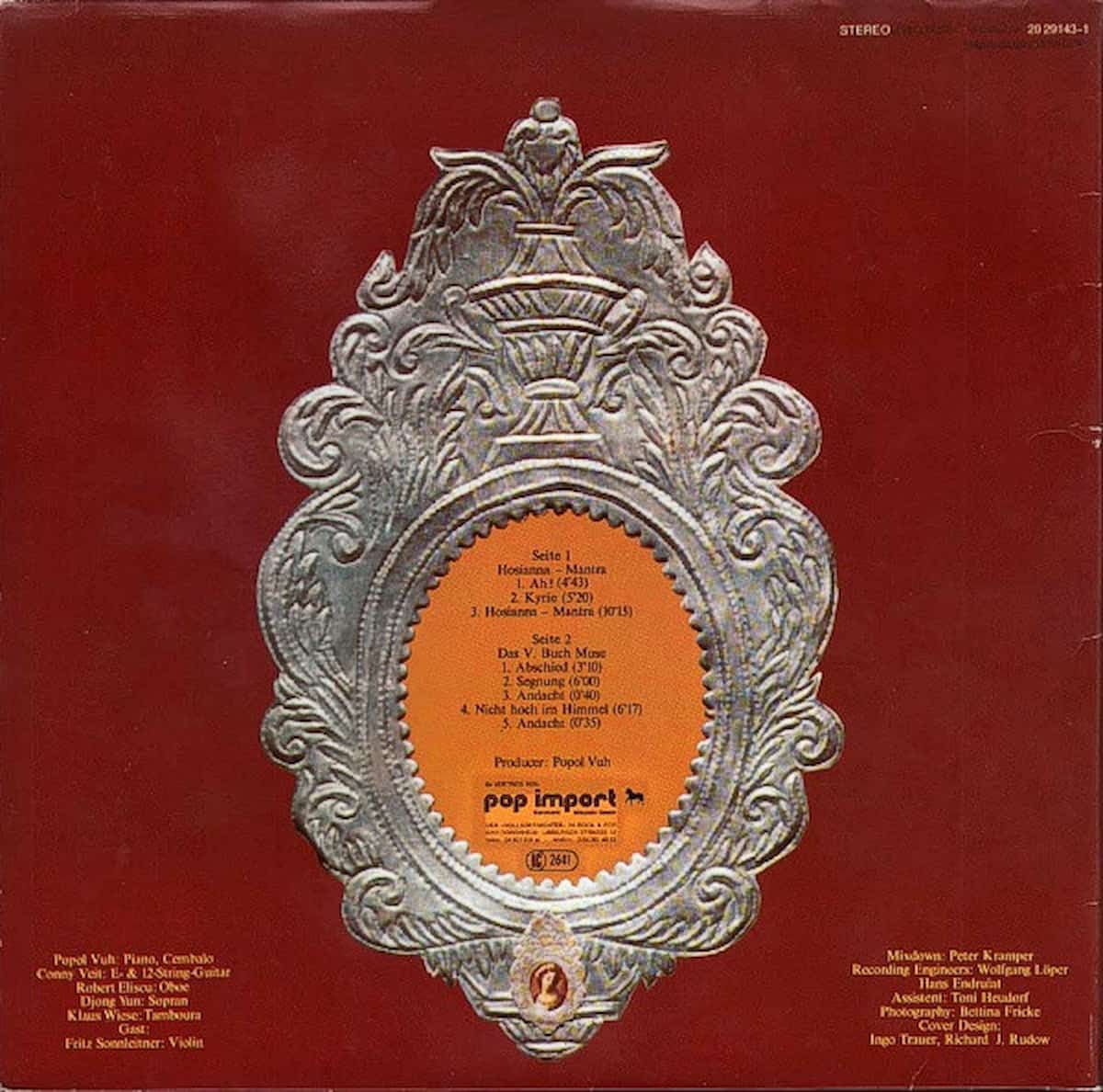
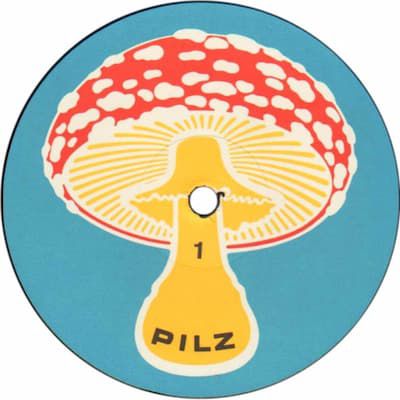

KING:
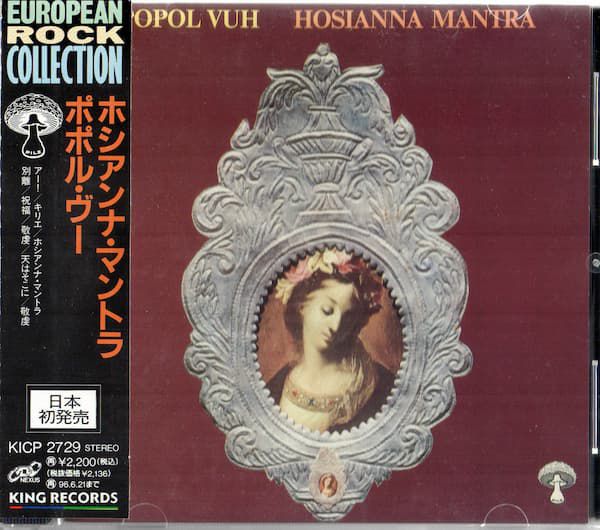
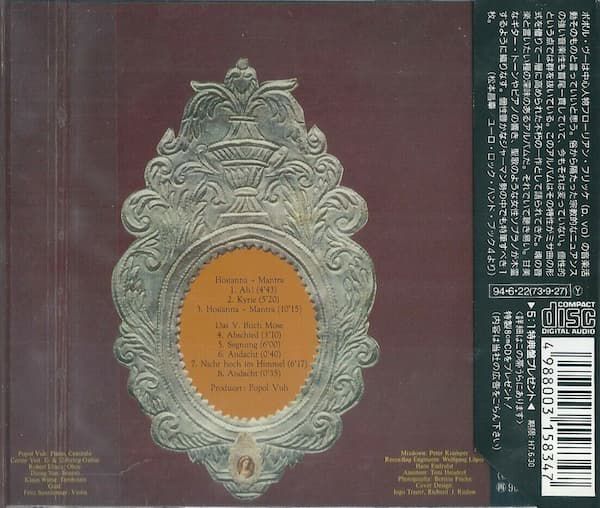
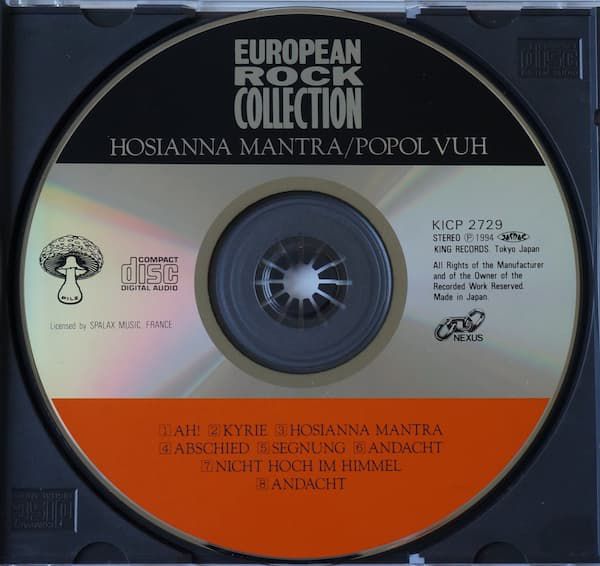
ANANDA:
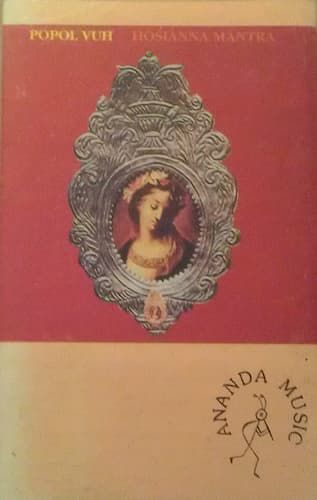
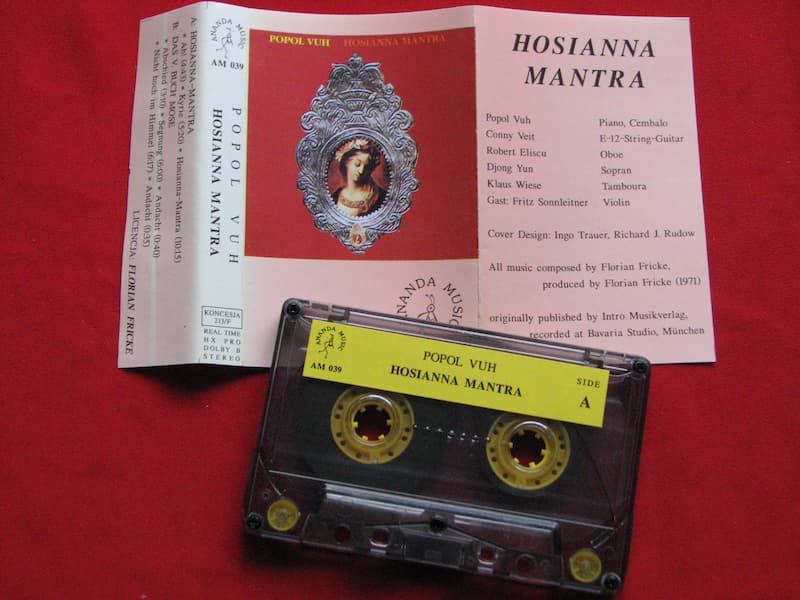
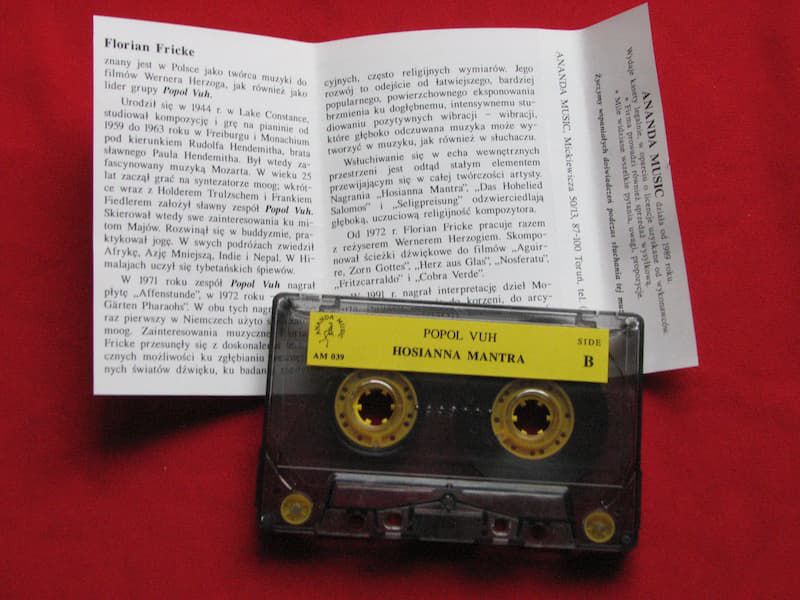
SPALAX:
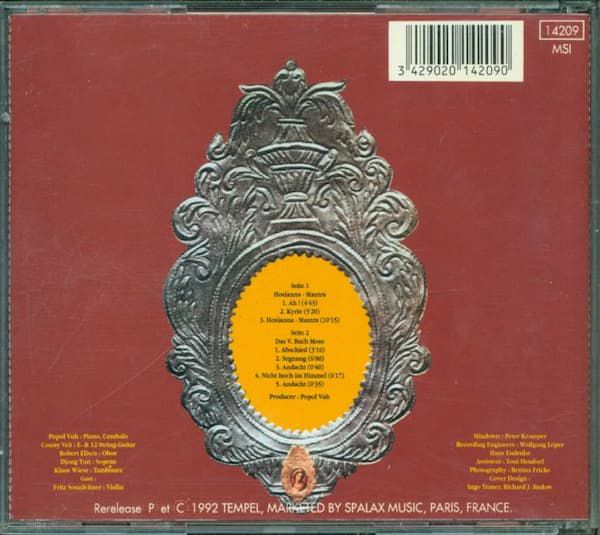
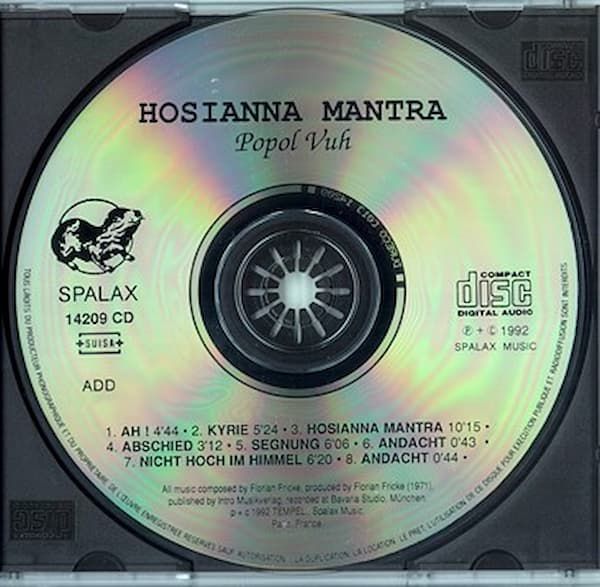
HIGH TIDE:
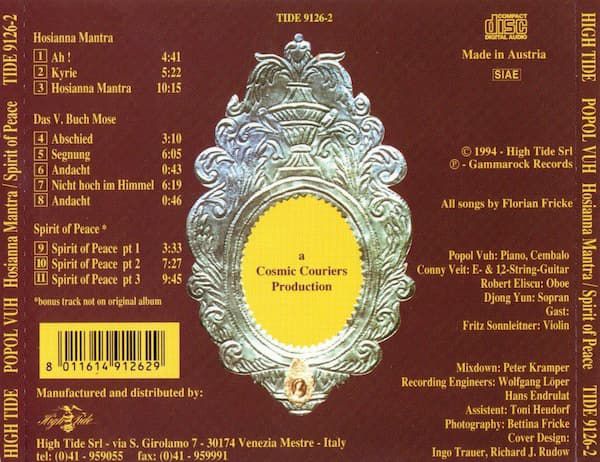
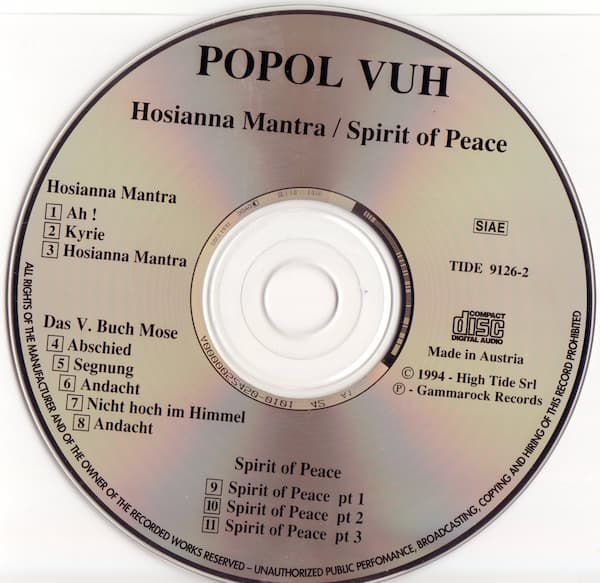
THINK PROGRESSIVE:
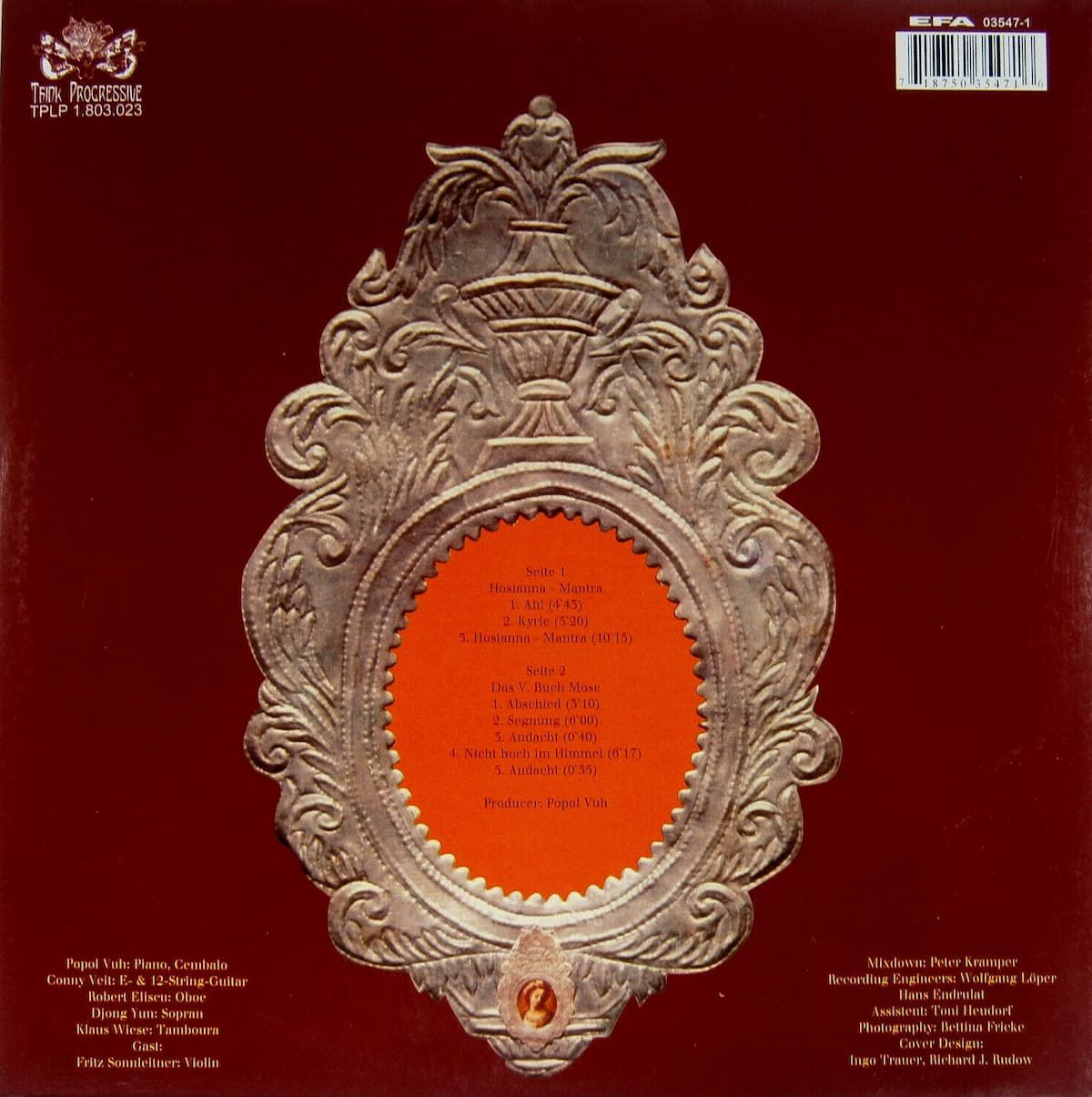
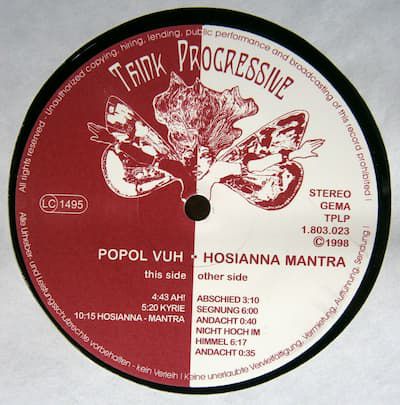
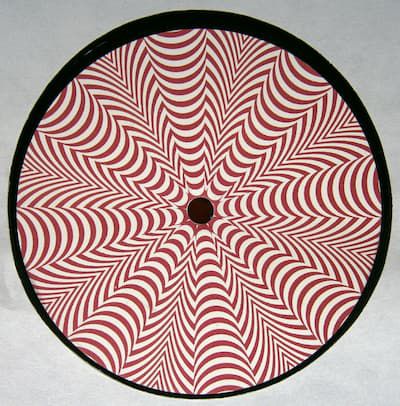
SPV:
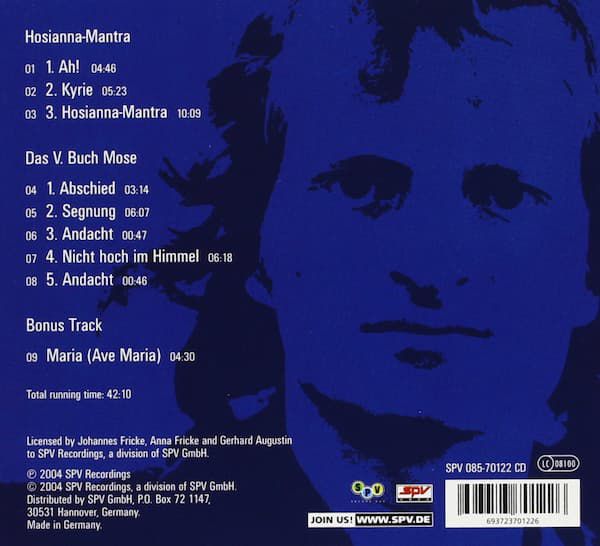
ARCANGELO:
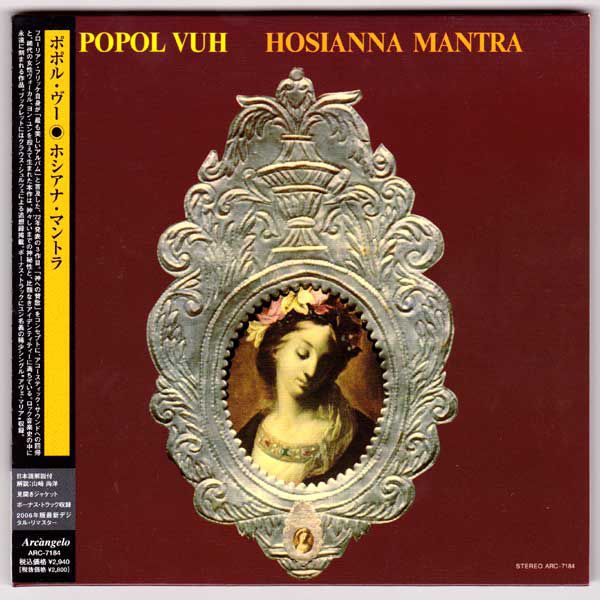
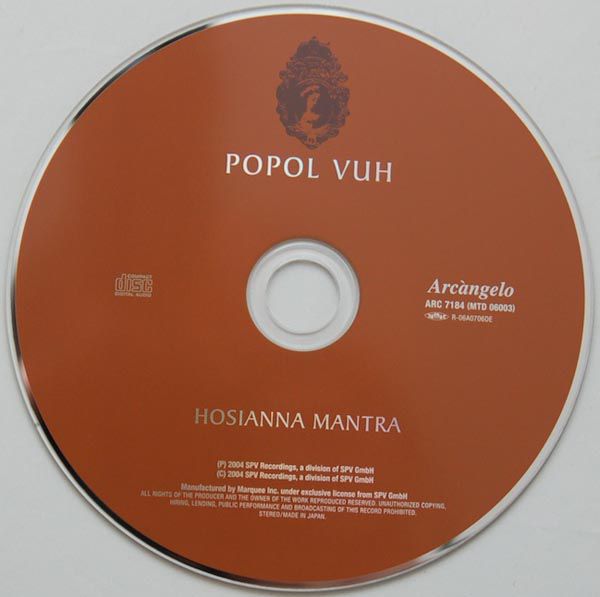
WAH WAH
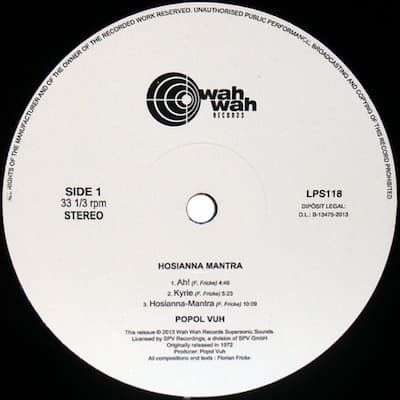
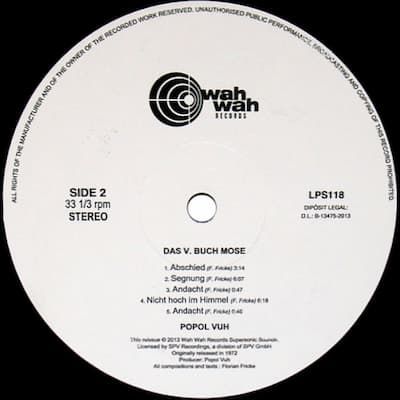
ESOTERIC RECORDINGS
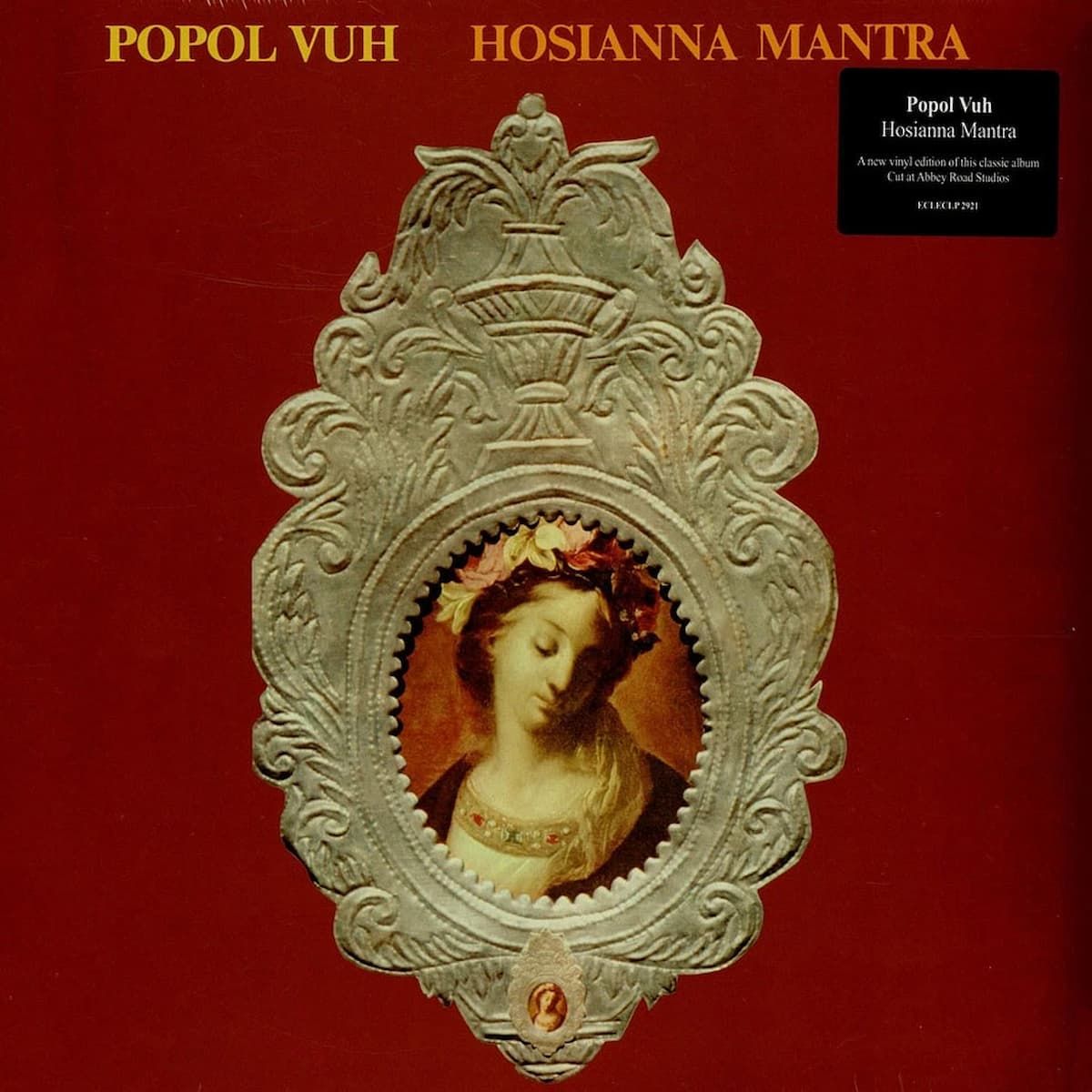
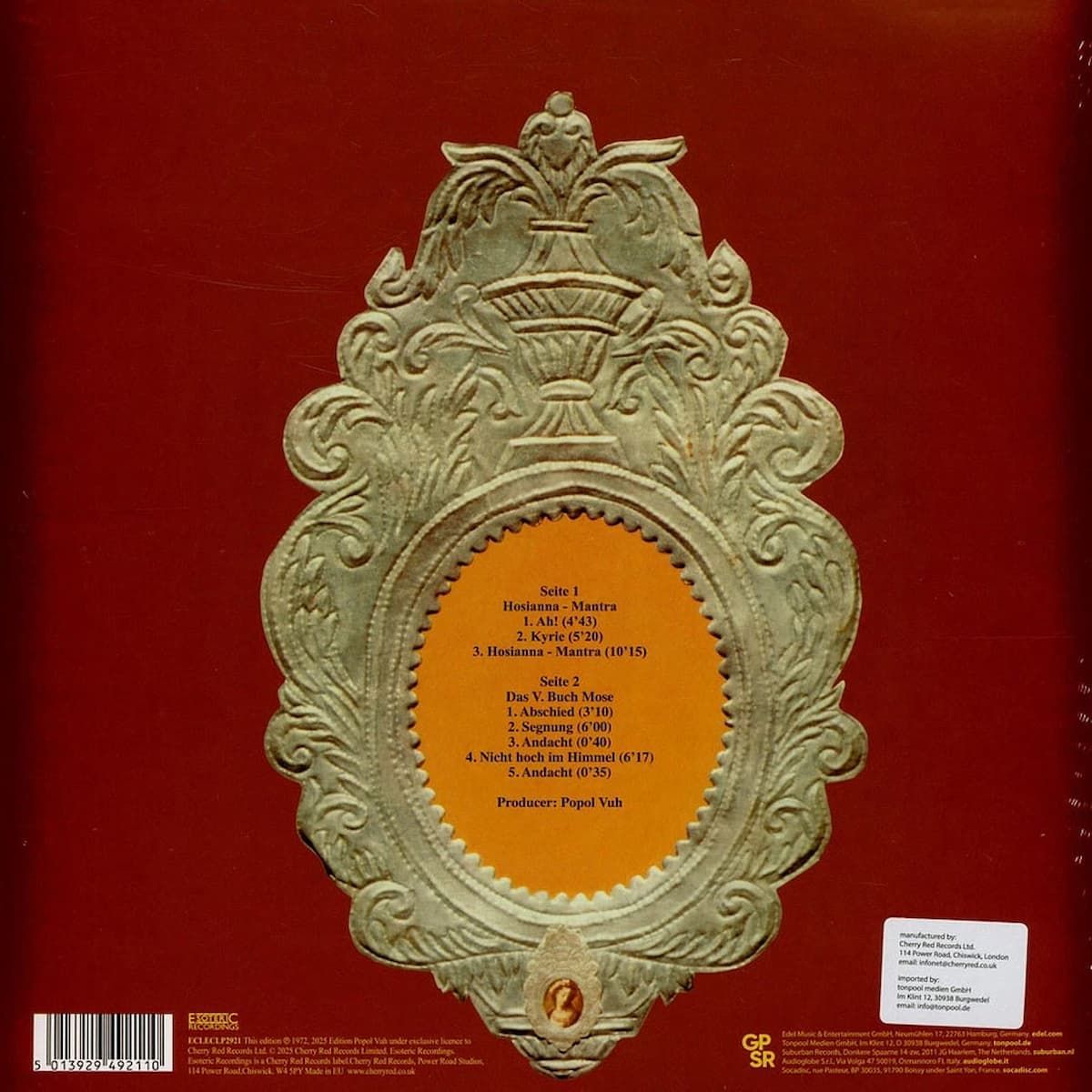
ECOS
